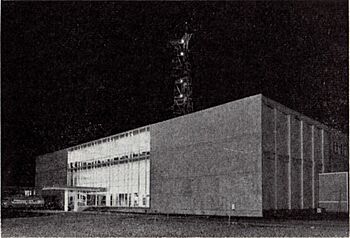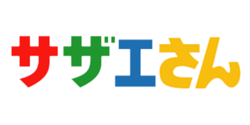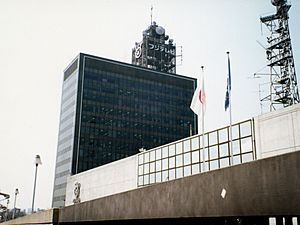Fuji Television facts for kids
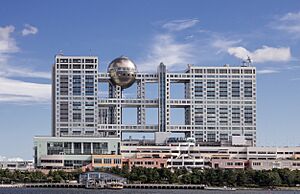
Headquarters of Fuji Media Holdings and Fuji Television in Odaiba, Minato, Tokyo
|
|
|
Native name
|
株式会社フジ・メディア・ホールディングス
|
|---|---|
|
Romanized name
|
Kabushiki gaisha Fuji Media Hōrudingusu |
|
Formerly
|
Fuji Television Network, Inc. (1957–2008) |
| Public | |
| Traded as | TYO: 4676 |
| Industry | Media |
| Founded | November 18, 1957 (as Fuji Television Network, Inc.) |
| Headquarters | 4–8, Daiba 2-chome,
,
Japan
|
|
Area served
|
Worldwide, with a focus in Japan |
|
Key people
|
|
| Products | Television Film Music |
| Services | Broadcast television and radio |
|
Operating income
|
¥31,401 million (consolidated, March 31, 2023) |
| ¥46,855 million (consolidated, March 31, 2023) | |
| Total assets | ¥848,769 million (consolidated, March 31, 2023) |
| Owner | The Master Trust Bank of Japan (11.17%) Toho (8.24%) Custody Bank of Japan (4.46%) Nippon Cultural Broadcasting (3.46%) Kansai TV (2.73%) NTT Docomo (3.42%) Northern Trust (2.49%) State Street Bank and Trust Company (2.14%) Yakult Honsha (1.76%) |
| Subsidiaries | Fuji Television Network Nippon Broadcasting System Fuji Satellite Broadcasting Pony Canyon Fujisankei Communications International Fuji Creative Corporation Fuji Consumer Products Fusosha Publishing Sankei Shimbun Co., Ltd. (39%) Sendai Television (72.4%) |

Logo used since 1986
|
|
| Kantō region Japan |
|
|---|---|
| City | Tokyo |
| Channels | Digital: 21 (UHF) Virtual: 8 |
| Branding | Fuji Television |
| Programming | |
| Language(s) | Japanese |
| Affiliations | Fuji News Network and Fuji Network System |
| Ownership | |
| Owner | Fuji Television Network, Inc. |
|
Sister stations
|
|
| History | |
|
First air date
|
March 1, 1959 |
|
Former call signs
|
JOCX-TV (1959–2011) |
|
Former channel number(s)
|
Analog: 8 (VHF; 1959–2011) |
|
Call sign meaning
|
JOCX Chūō (Central) Television, former provisional name |
| Technical information | |
|
Licensing authority
|
MIC |
| ERP | 68 kW |
| Transmitter coordinates | 35°39′31″N 139°44′44″E / 35.65861°N 139.74556°E |
| Corporate information | |
| Company | |
|
Native name
|
株式会社フジテレビジョン
|
|
Romanized name
|
Kabushiki-gaisha Fuji Terebijon |
| Subsidiary KK | |
| Industry | Media |
| Founded | October 1, 2008 |
| Headquarters | 4-8, Daiba Nichome,
,
Japan
|
|
Key people
|
|
| Services | Television broadcasting |
| Parent | Fuji Media Holdings |
| Subsidiaries | David Production Fuji News Network Fuji Network System |
Fuji Television, also known as Fuji TV, is a major Japanese TV station. It broadcasts to the Kantō region and is the main station for the Fuji News Network (FNN) and the Fuji Network System (FNS). The station is owned by Fuji Television Network, Inc. This company is part of a larger group called Fuji Media Holdings, Inc.
Fuji TV's main office is in Odaiba, Minato, Tokyo. It is one of the five big private TV broadcasters in Tokyo. Fuji TV also runs three special TV channels. These are "Fuji Television One" (for sports and variety shows), "Fuji Television Two" (for dramas and anime), and "Fuji Television Next" (for live premium shows). All these channels are available in high-definition.
The current Fuji Television company started in October 2008. Fuji Media Holdings is the original Fuji Television company, which changed its name in 2008. In its early years, Fuji TV's ratings were average. But in the early 1980s, its popularity grew a lot. In 1982, it became the top station in ratings for the first time. It created many popular TV dramas and variety shows. In 1997, Fuji Television moved its headquarters to Odaiba. This move helped develop the Odaiba area. After 2010, Fuji TV's ratings went down. However, Fuji TV also earns a lot of money from businesses outside of just TV broadcasting. It was also the first TV station in Japan to create and broadcast its own animated series.
Contents
- Where to Find Fuji TV: Offices Around the World
- Fuji TV's Look: Logos and Branding
- Fuji TV's Journey: A Look at Its History
- How Fuji TV Broadcasts
- Fuji TV's Networks
- What to Watch: Fuji TV's Programming
- Images for kids
- See also
Where to Find Fuji TV: Offices Around the World
Fuji TV has its main office in Odaiba, Minato, Tokyo, Japan. It also has an office in Kita-ku, Osaka for the Kansai region. Another office is in Higashi-ku, Nagoya for the Nagoya area.
Beyond Japan, Fuji TV has 12 offices in other countries. These include places like France, Russia, the United States, Indonesia, China, Thailand, and the UK.
Fuji TV's Look: Logos and Branding
The very first logo for Fuji TV was designed by Yusaku Kamekura. It was based on the station's channel number, "8." This was known as the "8 Mark." Even after a new logo came out, the "8 Mark" was still used in some places. For example, there is a sculpture of it at the entrance of the FCG building.
In 1985, the Fujisankei Group, which Fuji TV is part of, decided to create a new logo for all its companies. They chose the "eyeball logo," designed by Masaru Yoshida. This logo became the official symbol for Fuji TV and other group companies starting April 1, 1986. The group spent a lot of money on advertising to make sure everyone knew the new logo.
Fuji TV's Journey: A Look at Its History
Starting Out: The Early Years
In 1957, the Japanese government planned to create new TV channels. There was a lot of competition to get a license for a private TV station. Two radio stations, Nippon Cultural Broadcasting and Nippon Broadcasting System, teamed up. They later joined with film companies to form "Fuji Television." On July 8, 1957, Fuji TV got its broadcasting license.
Fuji TV started preparing for broadcasts. They bought land in Shinjuku for their main building. On November 28, 1958, Fuji Television changed its name to use the simpler Japanese writing (katakana) because the old writing (kanji) was hard to see on TV screens.
Fuji Television Network Inc. was founded in 1957 by Nobutaka Shikanai and Shigeo Mizuno. They were presidents of Nippon Broadcasting System and Nippon Cultural Broadcasting.
On January 10, 1959, Fuji TV began trial broadcasts. The official broadcasts started on March 1, 1959. A month later, Fuji TV helped broadcast the wedding of Crown Prince Akihito. This event helped make TV very popular in Japan. At first, some people couldn't watch Fuji TV because it was on channel 8, and older TVs only went up to channel 6. Fuji TV worked with electronics companies to make new TVs that could receive more channels.
In June 1959, Fuji TV started working with other TV stations like Kansai TV. This was the beginning of Fuji TV building its own network. A year after starting, Fuji TV's ratings were as good as other big stations. In 1961, Fuji TV became the first Japanese TV station to broadcast almost all day long. Fuji TV also helped broadcast the 1964 Summer Olympics.
In 1966, the Fuji News Network (FNN) was officially created. This network shared news programs across Japan. The Fuji Network System (FNS) was also formed in 1969. By the end of 1969, Fuji TV had 21 stations in its network. Fuji TV also worked with international companies. It partnered with NBC in the US in 1960 and MBC in South Korea in 1970. In 1963, Fuji TV aired its first live broadcast from overseas. This was a special program about the assassination of John F. Kennedy.
The Age of Color Television
In September 1964, Fuji TV showed its first color TV program. It was a British science fiction series called Stingray. In 1967, Fuji TV started making its own color programs. By 1970, even the news studio was broadcasting in color. Fuji TV also brought new technology in the 1970s. In October 1978, it started broadcasting in stereo sound.
In 1968, Fuji TV joined with other companies like Sankei Shimbun to form the Fuji Sankei Group. Fuji TV became a key part of this group. In 1969, Fuji TV celebrated its 10th anniversary with special programs. Its network continued to grow, becoming one of the largest private TV networks in Japan by 1970.
In the mid-1970s, Fuji TV's ratings dropped compared to other stations. To fix this, Fuji Television cut its budget. However, Fuji TV also started to expand into other areas besides TV. In 1974, it helped organize the Mona Lisa Japan Exhibition, which attracted many visitors.
Becoming a Top Station: The Golden Ages
In 1980, Nobutaka Shikanai, the first chairman of Fuji Television, stepped down. Haruo Kanai took over and made big changes. He changed Fuji TV's slogan to "It's not TV if it's not fun." In July 1981, Fuji TV became the top station in ratings for the first time. In 1982, it won the "Triple Crown" in ratings, meaning it was number one in all key time slots. Fuji TV also became the top choice for advertisers.
On April 1, 1986, Fuji Television changed its logo to the "Eye" logo used by the Fujisankei Communications Group. Fuji TV also worked with Nintendo to create video games for the Famicom. One game, Yume Kojo: Doki Doki Panic, later became the basis for Super Mario Bros. 2.
From 1987 to 1996, Fuji Television used special names for its late-night shows. These shows were experimental and gave young creators a chance to try new ideas. Fuji Television also helped produce the British children's show Thomas & Friends.
In 1991, Fuji Television decided to move its headquarters to the Odaiba area. This move was to prepare for new digital and satellite TV technologies. On March 10, 1997, Fuji TV officially moved to the new Fujisankei Group Building in Odaiba. They broadcast special programs for seven nights to celebrate the move. Fuji TV's drama series were very popular that year. In August 1997, Fuji TV's stocks were listed on the Tokyo Stock Exchange. This made it the third major TV station to have its stocks publicly traded.
In 2000, BS Fuji began broadcasting. With other channels launched in 1998 and 1999, Fuji TV entered the satellite TV world. By 2002, over 1 million people subscribed to Fuji TV's pay channels. On December 1, 2003, Fuji TV started broadcasting digital TV signals. The next year, Fuji TV became the top station in ratings again after 11 years.
In 2008, Fuji Television changed its structure. It became a holding company called Fuji Media Holdings, Inc. A new company, Fuji Television Network Inc., took over the broadcasting business. This was the first time a Japanese commercial broadcaster did this. In the same year, Fuji TV launched its online video service, Fuji TV On Demand (FOD). On July 24, 2011, Fuji Television stopped its analog TV broadcasts.
Fuji Television has broadcast Formula One races in Japan since 1987. It is the only media company that sponsors a Formula One Grand Prix.
Recent Changes and Future Focus
In the 2010s, Fuji TV's ratings went down. In 2011, another station took over Fuji TV's top spot in ratings. Fuji TV's advertising money also decreased. To try and fix this, Fuji TV made changes, like stopping some long-running shows. However, these changes did not immediately improve ratings.
Despite lower traditional TV ratings, Fuji TV is doing well with younger audiences (13-49 age group), which advertisers value. Fuji TV is also investing in new media like its online video service, FOD, which has become profitable.
Fuji Media Holdings is also working to grow other parts of its business outside of TV. Since April 2022, Fuji TV has started broadcasting its evening programs online at the same time they are on TV. In July 2022, Koichi Minato became president of Fuji TV. He focused on strengthening entertainment programs like variety shows and dramas. In 2023, Fuji TV started a new live variety show during weekday lunchtimes. Fuji Media Holdings also announced that it got the rights to broadcast the Asian Games, starting with the Hangzhou 2022 event.
On September 27, 2024, Fuji TV and Fuji Media Holdings announced a new company called Fuji Consumer Products. This company will handle licensing and marketing for shows like Chuggington and characters Gachapin & Mukku.
Programming Updates
On March 1, 2025, Fuji TV launched a YouTube channel for documentaries. It features shows like "The Non-Fiction Stream." On March 3, 2025, Fuji TV announced changes to its weekday evening variety show slot. It was shortened from 40 to 30 minutes. Also, the Thursday midnight anime slot "Noitamina" moved to Fridays at 11:30 p.m. in April 2025.
How Fuji TV Broadcasts
Digital Broadcasting
JOCX-DTV is the digital signal for Fuji TV.
- You can find it on remote control button 8.
- It broadcasts from Tokyo Skytree on Channel 21.
Relay Stations
Fuji TV has many relay stations that help its signal reach more areas. These include:
- Tokyo areas like Hachioji and Tama.
- Islands in Tokyo like Chichijima and Hahajima.
- Prefectures like Ibaraki Prefecture (Mito, Hitachi), Tochigi Prefecture (Utsunomiya), Gunma Prefecture (Maebashi), Saitama Prefecture (Chichibu), Chiba Prefecture (Narita, Tateyama, Choshi), and Kanagawa Prefecture (Yokosuka-Kurihama, Hiratsuka, Odawara).
- Even some overseas locations like San Francisco, California, New York, and Honolulu, Hawaii in the U.S. show selected Fuji TV programs.
Fuji TV's Networks
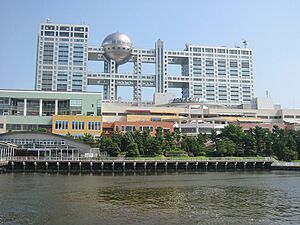
Fuji Television's shows are seen all over Japan. This is thanks to 28 stations that are part of the Fuji News Network (FNN) for news and the Fuji Network System (FNS) for general shows. The FNS also puts on a yearly telethon called FNS Day: 27 Hours of TV.
Fuji TV also has control over or shares control of several satellite and subscription TV channels:
- Channels managed directly by Fuji TV: Fuji TV One, Fuji TV Two, Fuji TV Next.
- Channels related to Fuji Media Holdings: BS Fuji, Nihon Eiga Broadcasting.
- Other channels: Daifu (Chinese channels in Japan), Wowow (Fuji TV is a shareholder).
What to Watch: Fuji TV's Programming
Anime Shows
Fuji TV has aired many popular anime series, including:
- Anohana: The Flower We Saw That Day
- Demon Slayer: Kimetsu no Yaiba
- Dragon Ball series (like Dragon Ball Z, Dragon Ball Super)
- Digimon series (like Digimon Adventure, Digimon Ghost Game)
- One Piece
- Yu Yu Hakusho
Tokusatsu Shows
Tokusatsu are live-action shows with special effects. Fuji TV has shown:
- Mirrorman (1971–1972)
- Toei Fushigi Comedy Series (1981–1993)
- Megaloman (1979)
Drama Series
Fuji TV is known for its Japanese dramas, such as:
- Long Vacation (1996)
- Bayside Shakedown (1997)
- Hero (2001)
- 1 Litre of Tears (2005)
- Nodame Cantabile (2006)
- Galileo (2007)
- Last Friends (2008)
- Priceless (2012)
- Good Morning Call (2016)
Cooking Shows
- Iron Chef (1993–1999)
- Top Chef (international partner)
- Kuishinbo! Bansai (1974 - 2025) (currently paused)
News and Information Programs
Fuji TV provides many news programs throughout the day:
- Mezamashi TV (April 1994 – present) - A popular morning news show.
- Sun! Shine (March 2025 – present) - Another morning news program.
- Live News days (April 2019 – present) - News before noon.
- Live News it! (April 2019 – present) - Evening news.
- Live News α (April 2019 – present) - Night news.
- Kids News - A weekly news program for children.
- Mr. Sunday (2010- ) - A Sunday news and information show.
Variety Shows
Fuji TV has many fun variety shows:
- IQ Sapuri
- Toribia no Izumi
- Mecha-Mecha Iketeru!
- Waratte Iitomo! (October 1982 – March 2014) - A very long-running and famous talk show.
- Itadaki High JUMP (2015–2024)
- Kinki Kids Bun Bun Bun (2014–2024)
- All Night Fuji (1983-1991)
- Chidori no Oni Renchan (2022- )
- One Night Study (2025– )
Music Shows
- Hey! Hey! Hey! Music Champ (October 1994 – December 2012)
- Music Fair (1964- ) - A long-running music program.
- FNS Music Festival (1974-2024)
- Idoling!!! (2006–2015)
- Music Generation
Talk Shows
- Dareka to Nakai (February 4, 2024) - This show was suspended in January 2025.
Reality Television
- Ainori (October 11, 1999 – March 23, 2009) - A dating show where people traveled the world in a pink van.
- VivaVivaV6 (April 2001 – present)
- Game Center CX (2003–present)
Game Shows
- Brain Wall (known as Hole in the Wall in the US)
- Quiz $ Millionaire (Japanese version of Who Wants to Be a Millionaire?)
- Run for money: Tōsō-chū (June 2004 – Current) - A large-scale game of tag where contestants try to avoid "Hunters." This show has inspired games, an anime, and a movie.
- Vs. Arashi (April 2008 – 2020)
- VS Damashii (January 2021 – September 2023)
Sports Coverage
Fuji TV covers many sports events:
Current Sports
Football (Soccer)
- FIFA World Cup (including qualifiers)
- Japan national football team matches
- YBC Levain Cup
- FIFA Women's World Cup
- Japan women's national football team matches
Figure Skating
- World Figure Skating Championships
Baseball
- Nippon Professional Baseball
Volleyball
- FIVB Volleyball Men's World Cup
- FIVB Volleyball Women's World Cup
- FIVB Volleyball Men's Nations League
- FIVB Volleyball Women's Nations League
Boxing
Judo
- World Judo Championships
Horse-racing
Motorsport
- Formula One
- Super Formula Championship
Multi-sport Events
Former Sports
Basketball
Golf
- Fujisankei Classic
Mixed Martial Arts
- Rizin Fighting Federation
Volleyball
Images for kids
See also
 In Spanish: Fuji Television para niños
In Spanish: Fuji Television para niños
- Fujisankei Communications Group
- Television in Japan
- Hobankyo – An organization in Japan that protects Fuji Television's copyrights.
- Yukino Kikuma



